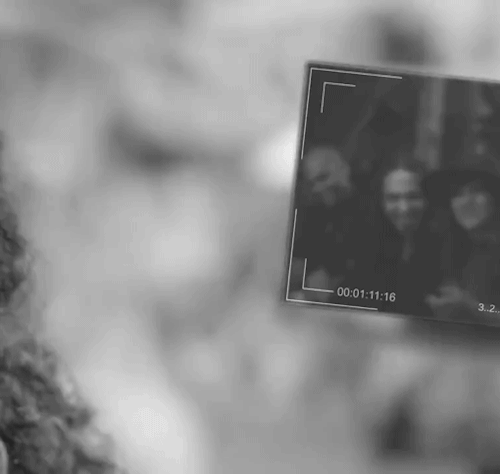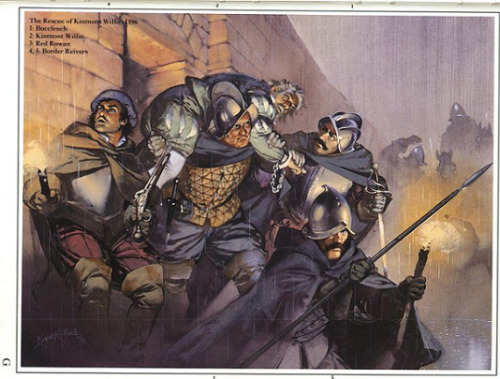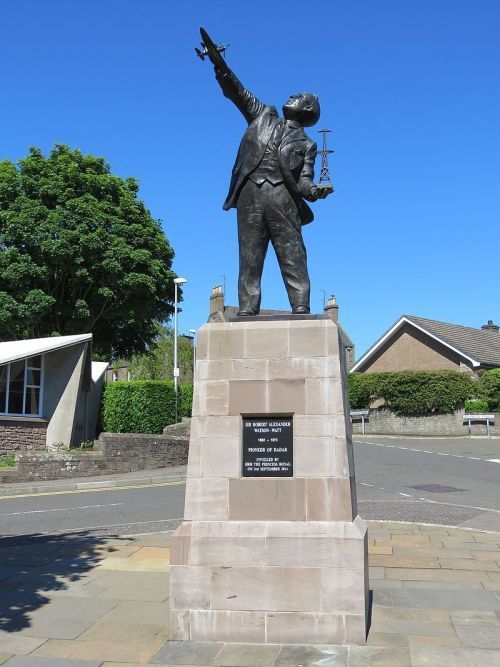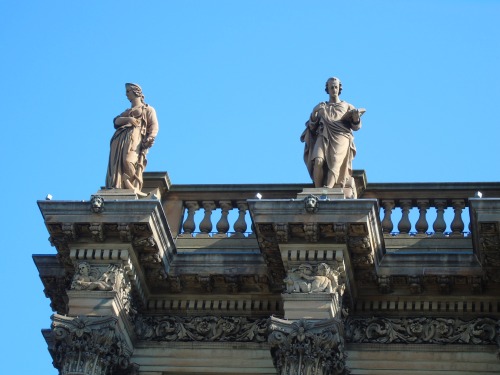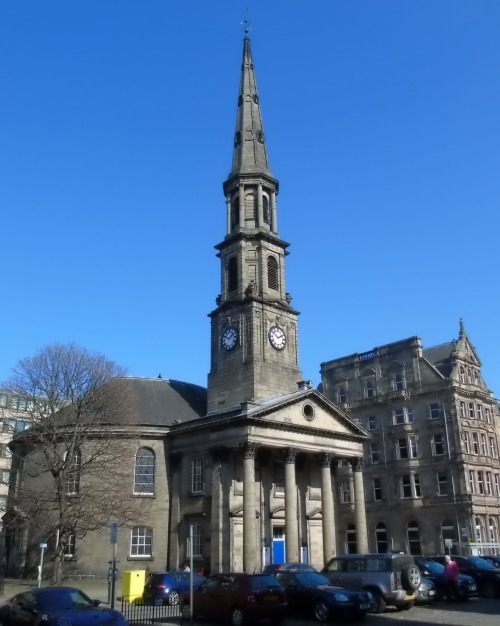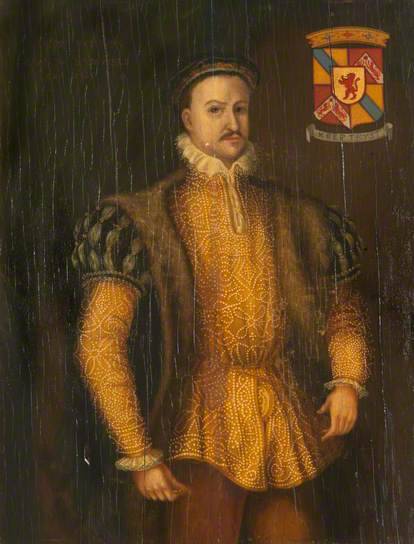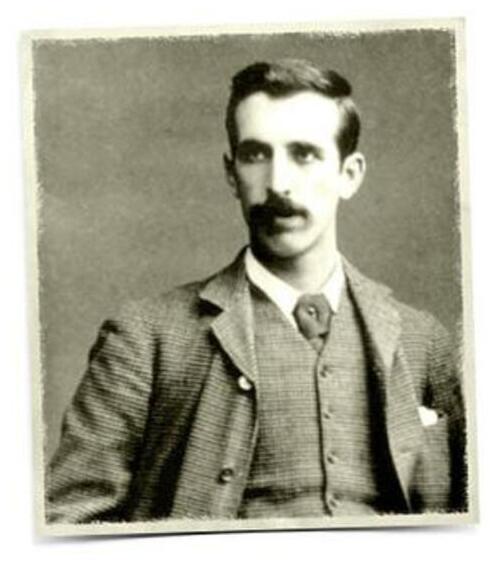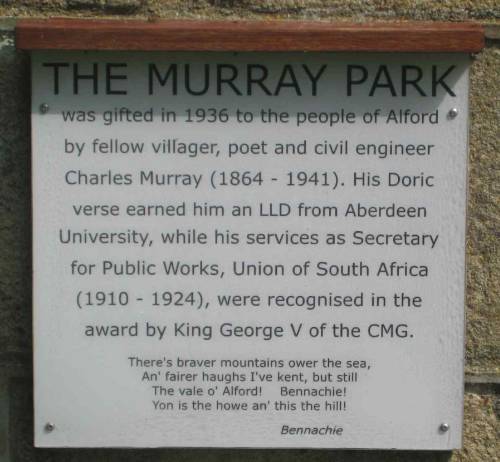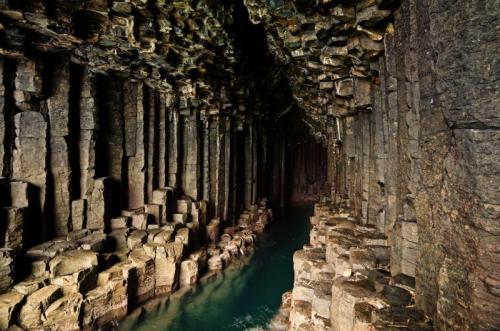#scottish
On April 13th 1596 Walter Scott of Buccleuch freed notorious reiver William Armstrong of Kinmont in a daring raid on Carlisle Castle.
Perhaps the best known of the Border reivers (outlaw raiders or rustlers), William Armstrong of Kinmont’s first recorded raid was against the Milburns of Tyndale, in August 1583, when Armstrong was probably in his forties. In 1585 he accompanied the Earl of Angus`s campaign against the Earl of Arran and pillaged Stirling. Eight years later he was in Tynedale again with 1,000 men, carrying off over 2,000 beasts and £300 in spoils.
The events of 1596 and the rescue of ‘Kinmont’ Willie Armstrong represent a daring swashbuckling adventure. The fact that Kinmont led one of the most notorious bands of cut-throats ever to roam the Debatable Land seems to be irrelevant and in the tradition of the Border ballads we are to view him as a hero. His notoriety and activities were such that the Warden of the West Marsh’s deputy, Salkeld, captured Kinmont as he returned from a Truce Day at the Dayholm of Kershope. Kinmont was taken to Carlisle.
According to Border Law it should not have happened on a Truce Day and Walter Scott of Buccleuch who became known as The Bold Buccleuch, and was keeper of Liddesdale on whose land the arrest had been made, protested to the Warden, Lord Scrope. When Scrope refused to return Kinmont, Buccleuch became concerned that Scrope was anxious to hang Kinmont on the gallows at Harraby and so assembled a motley bunch of Elliots, Scotts, Armstrongs and Grahams to effect a rescue. Oral tradition has meant that the numbers vary from 40 to 200. The weather was atrocious which made crossing the River Eden very dangerous, but it did mean that the castle watch had taken shelter. Buccleuch left a group to cover the retreat and led the raiding party himself. Popular opinion has it that they must have had support from the inside because they entered the castle quickly. Thus with the aid of a sturdy Reiver, Red Rowan, Kinmont made his escape.
In 1600, Armstrong attacked the village of Scotby with 140 riders, burning and taking prisoners and cattle. In 1602 he rode his last foray, south of Carlisle. He was still alive two years later, and his four sons who had helped to get him out of Carlisle Castle are frequently named in the later Border raids. Legend supposes he died in his bed of old age, sometime between 1608 and 1611.
As is usual with these Border legends we look to the old sources of the story tellers before reading and writing was the norm, the old songs. Francis James Child was an American scholar and collector of Ballads, if you follow my posts you will no doubt have seen me posting “Child Ballads” at times, this story comes from Child Ballad 186. This ballad is more unusual than most of the songs I know from the Child Ballads as it is longer than most at 20 verse so I wont post it, you can look it up on YouTube as Child Ballad 168, but it’s over 9 minutes wrong in full!
Post link
Happy Birthday the often underrated World Champion boxer Ricky Burns born April 13th in Coatbridge.
Ricky has had a sterling career as one of the best British boxers of recent times. He has repeatedly upset the odds to win world titles at three separate weight divisions – Super Featherweight, Lightweight and Super Lightweight. Ricky has made history by becoming the first Scottish fighter to hold a world title in 3 different weight categories!
Ricky is considered one of boxing’s “nice guys” as well as a superb role model. He recently made a comeback, winning a fight against Argentina’s Emiliano Dominguez Rodriguez by unanimous decision in Sunderland in December, his first fight in two years.
Ricky hasn’t mentioned an opponent yet, but hopes to be back in the ring again soon.
Post link
Robert Watson-Watt was born on 13th April 1892 in Brechin.
Robert had big boots to fill, he claimed he was a descendant of James Watt, although no evidence of any family relationship has been found. But like Watt he went on to make his own important contribution to the world as a pioneer of radar technology.
Although he did not invent the idea of radio detection, Watson-Watt was the first to prove it could work on a large scale.
Born the son of a carpenter and cabinet maker, he attended Damacre Road School, where he was awarded the ‘Smart Medal’ as ‘Dux’ (top prize-winner) of Brechin High School.
He went on to study at University College in Dundee, then part of St Andrew’s University. After he graduated with a BSc in Engineering, his professor William Peddie encouraged him to continue to study 'wireless telegraphy’. This was the common name for radio at the time.Watson-Watt was employed as a meteorologist at the Meteorological Office in 1915.
He worked on equipment that could detect thunderstorms, researching how to detect lightning and the signals emitted as it ionises the surrounding air. His research was aimed at giving airmen in fragile aircraft advance warning of potential lightning strikes.
In 1916 Watson-Watt had the idea of using a cathode ray oscilloscope in aircraft to measure and plot electrical signals on a display screen. However, his idea was not realised until 1923.
In 1924 he moved from Farnborough to work at the newly established research centre at Ditton Park near Slough. The research centre joined with the National Physical Laboratory and Watson-Watt took charge of the Radio Department in Teddington, Middlesex.
One of his projects was to investigate radio interference and how it might be used to advantage in wartime. The Air Ministry set up a committee to advance air defences in the UK in 1933. Nazi Germany claimed to possess a 'death ray’, which used radio waves said to be capable of destroying targets in Britain.
Watson-Watt was asked to develop a response to this threat – a ray that could destroy German aircraft before they attacked. He believed such a thing was not feasible. However, he believed he could develop a machine able to detect an aircraft in flight before it was visible.
The pioneering work that Watson-Watt undertook resulted in the design and installation of a chain of radar stations along the East and South coast of England in time for the outbreak of war in 1939. This system, known as Chain Home and Chain Home Low, provided the vital advance information that helped the Royal Air Force to win the Battle of Britain.
Post link
April 13th 1996 saw the death of the Orkney Poet and writer George Mackay Brown.
George Mackay Brown is perhaps Orkney’s best known author. He was born in Stromness in 1921 and his poetry, plays, novels and short stories continue to have an impact worldwide.
His work was inspired by Orcadian folklore – the myths, legends and sagas - Orkney’s Norse heritage, the natural landscape, his childhood and exploration of his faith. He wrote about his hometown of Stromness and chronicled the lives of the people who lived here and the way of life.
After six years as the Stromness correspondent for the Orkney Herald and a period recovering from tuberculosis, GMB, as he is often referred to in Orkney, from 1951 studied at Newbattle College in Midlothian under warden Edwin Muir, a fellow Orcadian writer. He went on to read English at Edinburgh University, returning to Orkney in 1961.
While in Edinburgh of course he drifted towards the crowd in Milnes Bar and into the company of Hugh MacDiarmid, Norman MacCaig and the likes. He met and fell in love with Stella Cartwright described as the bars muse and she was lover to a number of Scottish poets, they were briefly engaged but kept in touch until she passed away in 1985.
Dubbed by some as the Orkney bard, his first book of poems sold out in days. Despite almost continual ill-health he continued to write and gained numerous prizes for his work. These included the James Tait Memorial Prize for his novel The Golden Bird: Two Orkney Stories. Beside the Ocean of Time was shortlisted for the Booker Prize and won the Scottish Book of the Year title from the Saltire Society. He was awarded the OBE and three honorary degrees.
His weekly column which ran for more than 25 years in The Orcadian from 1971 is in print in book form and gives an insight into his Stromness routines and his observations on a changing Orkney.
George Mackay Brown died in 1996 but his legacy lives on in his words, and in the George Mackay Brown Fellowship.
https://georgemackaybrownfellowship.com/
Shroud.
Seven threads make the shroud,
The white thread,
A green corn thread,
A blue fish thread,
A red stitch, rut and rieving and wrath,
A grey thread
(All winter failing hand falleth on wheel)
The black thread,
And a thread too bright for the eye.
.
George Mackay Brown
Post link
On 13th April 1719 a small Spanish force, believing itself to be part of a much larger invasion planned for England to return the Jacobites to power, landed in Loch Duich, east of the site of what is now Kyle of Lochalsh.
The little known 'Little Rising’, saw a force of 300 Spanish soldiers land and combine with less than a thousand Highlanders, under George Keith, the 10th Earl of Marischal, William Mackenzie, the 5th Earl of Seaforth Lord George Murray and John Cameron of Lochiel.
The plan had been hatched by King Philip of Spain and Italian Cardinal Alberoni as a diversion to help in the campaign to restore Spanish power and territories ceded to the British following the Treaty of Utrecht. The Spanish force should have been much larger, but much of it had been destroyed by a storm. Added to this Highlanders did not join the Jacobites in the expected numbers, However, the Jacobites made their base at Eilean Donan Castle and intended to capture Inverness. Unfortunately, Hanoverian ships shelled the castle and the only battle was at Glen Shiel two months later when the Jacobites were defeated by a Government army led by General Joseph Wightman.
This uprising is often overlooked, the only “major” action was on June 10th at the Battle of Battle of Glen Shiel, more of that in a couple of months.
A wee added note to this, it was during this time that Eilean Donan was destroyed by Government ships bombarding it the ruined castle was abandoned until 1912 when it was purchased by Lieutenant-Colonel John MacRae-Gilstrap. Rebuilding was undertaken between 1914 and 1932 and it was at this time that a bridge was built to link the island to the shore. The pics shows how the castle looked in the two centuries between these events and the restoration, and the ruin, as it was.
Post link
Statues on the former Linen Bank, St. Andrew Square Edinburgh.
The building itself was designed by the eminent Scottish architect David Bryce and built between 1846-51. The statues are the work of Alexander Handyside Ritchie, a Musselburgh sculptor who had a studio at Mound Place and lived on Princes Street.
Canmore the online catalogue to Scotland’s archaeology, buildings, and industrial and maritime heritage, and part of Historic Environment Scotland/Historic Scotland describe the statues as such;
The bottom of the building is clad in ugly scaffolding just now, hence only the top half captured,
Navigation: female figure with an anchor by her left side and a stick(?) in her right hand.
Commerce: male figure with book in left hand and a large parcel tied with rope by his left foot.
Manufacture: a female figure with spindle(?) in left hand and a distaff in right hand.
Architecture: a female figure with a tablet of stone in her left hand.
Science: bearded male figure with a kind of bolt(?) in his right hand, his left hand holding a parchment on his left hip. At his right foot is an anvil and a hammer.
Agriculture: Female figure with wheat sheaf in right hand and a circle of wheat stalks in her left hand. Around her head are ears of whea0t.
They represent Navigation, Commerce, Manufacture, Science, Art and Agriculture.
And below the statues as;
On a frieze running below the figures are 6 putti. Each putto is directly below each figure and has further attributes:-
Navigation: putto with trident and sea creature.
Commerce: putto with globe and map.
The building housed The Bank of Scotland for some years and is now owned by Gleneagles Hotels and is being converted into a 33-room boutique hotel, called “Gleneagles Townhouse” There will also be a restaurant and bar in the hotel, and a rooftop terrace with views over the square.
https://gleneagles.com/townhouse/
Post link
St. Andrew’s and St. George’s West Church.
Built to an unusual oval design by Major Andrew Fraser of the Royal Engineers, opened in 1784 as St. Andrew’s Church, this was the first church in Edinburgh’s New Town.
Two churches, one St Andrew’s (for Scotland) and the other St George’s (for England), were planned as principal elements in the New Town and originally intended to face each other down the length of George Street, but Laurence Dundas acquired the intended plot in St Andrew’s Square first and built his town house, relegating the church to its present position. St Georges is now West Register House, with it’s fine green dome, which I used hide away in when I worked there in the late 80′s.
I’ve been inside this church a few times, it has a fine corniced ceiling and a mezzanine type gallery for parishioners to sit. I used to pop in when they had one of their regular book sale days, all the proceeds of the sales o to Christian Aid. They also have a community café downstairs in the Undercroft.
If you’re in Edinburgh during May it really is worth a wee look in, even if it’s just to have a nose about the place.
The house Dundas had built is at 36 St Andrew Square and has been the Head Office of RBS since 1825.
Check out the church website below.
Post link
Doorstep capture by Seònaid
Via Flickr:
I managed to photograph the Hebridean Princess cruise liner, from the doorstep as she sailed up the Sound of Sleat on a gorgeous March evening! Interestingly this lovely ship started off as a MacBrayne ferry.based in Oban and visiting the Scottish islands.
Street Art by Shona Hardie in Leith,.
The common nightingale is the Ukraine’s national animal. According to legend it once came to the country from India to cheer the people up with its singing. This one is holding a peace flag in its beak – as a sign of hope for the end of the war.
Post link
On 12th of April 1928 Madeleine Smith who stood trial in one of Scotland’s most sensational trials died peacefully in New York
Sex, blackmail, poison and death. With this heady mix it is hardly surprising that one of the most enduring murder cases from the past 150 years is the story of Madeleine Smith.
The 21-year-old lass was the daughter of a well known Glasgow architect and socialised in high circles until she was charged with the murder of a previous lover.
Her one-time lover had been Pierre Emile L’Angelier of Jersey. The Crown alleged that she had administered arsenic to him between 19th February and 23rd March that year, at or near her father’s house. L’Angelier had collapsed suddenly at his lodgings in Glasgow on 23rd March. He was found in a doubled-up position at the door in the early hours of the morning and despite constant medical attention by a doctor he died the following day.
After his death, his family insisted a post-mortem was conducted and the results were handed over to the police. A forensic examination detected over 30 grains of arsenic in his remains.
Previously, during their passionate affair, L’Angelier and Madelaine had corresponded through secret letters. L’Angelier often referred to his lover with the words “Wifie mine”. On one occasion Madelaine had written, “Am I not your wife? Yes, I am”, and there is reason to believe that L’Angelier assumed that they were married according to Scots law.
After L’Angelier’s death investigators uncovered the secret correspondence between the pair which revealed their passionate liaison and helped piece together the events surrounding L’Angelier’s suspicious death. It was discovered that, despite her affair with L’Angelier, Madelaine had been attracted to a Mr Minnoch, a high class member of society. Soon after, she became engaged to Mr Minnoch and wanted L’Angelier to return the letters. L’Angelier refused and threatened to bring them to the attention of her father and Minnoch. Madelaine buckled under the threats, and was forced to maintain L’Angelier’s company. His nightly visits resumed, but on two occasions he was seized with an inexplicable illness after being given a cup of cocoa from her hands. On the evening of his death witnesses testified that he had been seen heading in the direction of Madelaine’s house.
On her arrest Madeline’s family were said to be distressed and ashamed, however Miss Smith did not seem to suffer from the same discomfort. At her trial she entered the dock with “the air of a belle entering a ballroom or a box at the opera. Her steps were buoyant and she carried a silver-topped bottle of smelling salts. She was stylishly dressed and wore a pair of lavender gloves”.Throughout the trial she never appeared perturbed, and seemed to exert a peculiar fascination over the men in the court audience. She was later to tell her prison matron in a letter that she had received hundreds of letters “all from gentlemen, offering consolation, their hearts and money”.
Madelaine claimed that she had not seen L’Angelier for three weeks prior to his death. In her defence she explained that a poison she had recently purchased was for killing vermin and also for cosmetic purposes, diluted with water, to wash her face, arms and neck. The prosecution case rested on the overwhelming motive that the prisoner had for disposing of her erstwhile lover. The defence proceeded to allege that there was no evidence that the couple ever met on the days in question. It was even suggested that the heartbroken L’Angelier may have taken his own life in despair.
The jury took only half an hour over their deliberations. While they were absent, it was said that the least excited person in the court was Miss Smith. When the foreman delivered a verdict of “not guilty of the first charge by a majority, of the second charge not proven, and by a majority find the third charge also not proven”, the result was greeted with great applause. Madelaine Smith left the trial a free woman.
A short time after the trial, Miss Smith married a gentleman of good social standing in London. She emigrated to America some years later, where she married yet again. The story was famous in Victorian times for the reason that the public could not believe that a woman could be so devious. Madelaine became something of a femme fatale and was sensationalised as a devil woman who captured unsuspecting men in her web of deceit. There are still stories and articles written about her, the latest being in The Courier last November.
https://www.thecourier.co.uk/fp/entertainment/2738490/madeleine-smith/
Post link
The Scottish Suffragette Agnes Henderson Brown was born on April 12th 1866 in Edinburgh.
The term ‘suffragette’ was invented in 1906 by that bastion of everything bad, the Daily Mail, as meant to be a belittling epithet, but the women turned it around and adopted it as a badge of honour.
Nannie Brown, as she later became known as was born at 125 Princes Street, which is slap bang opposite the Castle. The street in those days would have been mainly a residential one, as it was meant to be in the plans for the New Town, George Street was meant to be the main shopping area.
Their father was interested in social and political reform and the house became a centre of cultural activity. The Dad ran a number of fruit shops under the title of William Brown & Sons he trained his daughters, Agnes and Jessie, well and refused to submit to laws that he objected to, he was an activist for women’s rights. His opposition to taxes that differentiated between genders caused him to end up in the notorious Calton Gaol in Edinburgh.
Agnes and her sister Jessie were among the first women to be seen on bicycles in Scotland. The safety bicycle was the direct ancestor of today’s machines. With a slight adaptation they attracted thousands of women to cycling and some historians point to the safety bicycle as the beginnings of suffrage, women’s rights and feminism.
Nannie and Jessie were known to heckle parliamentary candidates at meetings, Nannie was also a writer of stories, lectures, plays and articles. She was a member of The Scottish Women’s Rural Institute, as she grew older and unable to participate as much in demonstrations, her house in Castle Street became a haven for the SWRI who would seek out advice from her. They would hold ‘Scots evenings’ or ‘Dickens evenings’, at which stories, songs, and sketches were performed.
She also participated in societies such as the Edinburgh Dickens Fellowship, learned to type, this might seem trivial, but women were marginalised back then, hence the suffrage movement sprung up to right these things, it was said in an obituary the Nannie was the first woman to learn to type in all of Scotland.
Nannie Brown died on 1st December 1943 at 3 Blackford Road, Edinburgh and is buried beside her parents at The Dean Cemetery, sadly Wiki reports that the grave has been vandalised and is not the easiest to locate, I must try and seek it out the next time I am on a wander down that way.
The first two pics are from a newspaper reporting on their march to Selby, they also marched to John O’Groats to spread the word about women’s rights.
The third pic is from Ste[hen Dickson at Chaos Project who seek to remember unsung or undersung heroes and especially heroines whose graves are lost or forgotten. Go have a look at the page, it’s not been updated for a while, but has some interesting posts, they don’t go into detail, but one that caught my eye was “ Remembering the 115,000 unmarked graves in St Cuthbert’s Churchyard “
https://www.facebook.com/Chaos-Project-396319260884649/
Post link
April 12th 1913 Flyweight boxing champion was Benny Lynch born.
I always feel sad when telling the story of Benny Lynch who is widely regarded as one of the finest boxers that Scotland has ever produced. His explosive punching power, immaculate timing, and prolific skill ensured that he had no equals among his contemporaries in the flyweight division.
Born in the Gorbals in Glasgow on April 12th 1913, the young Lynch grew up in the squalor of one of the most overcrowded immigrant ghettoes in Europe. He loved life in this cosmopolitan melting pot and soon established himself as one of the community’s favourite sons. Having turned professional in 1931 at the, Benny honed his prodigious natural talent by demolishing all before him on the boxing booth circuit. Under the expert, avuncular stewardship of his trainer and manager, Sammy Wilson, the boy from Florence Street won the Scottish title from Jim Campbell in May 1934. In March 1935, he drew with reigning British, European and World flyweight champion Jackie Brown over 12 rounds, setting up a title-fight re-match six months later.
The second fight, in Manchester, was watched by hundreds of travelling Scottish supporters; their faith was to be rewarded as Lynch demolished Brown in an outstanding display of power punching that saw the English opponent and undisputed world champion for three years on the canvas a total of eight times in just two rounds. Scotland’s first ever world boxing champion returned to Glasgow to be met by a joyous crowd of hundreds of thousands of people who lined his triumphal route from Central Station to his home in the south side of the city. The city fathers of Glasgow Corporation denied him a formal welcome, but the people of Glasgow turned out to pay tribute the likes of which had never been seen before and would never be seen again: one of them who had denied all the odds to rise to the very apex of his profession.
Unfortunately, fame did not sit easily on Lynch’s frail shoulders and his battle with the bottle and his personal demons proved to be more difficult to overcome. Lynch regularly struggled to make the 112lb weight limit and lost his title on the scales in 1938, stripped for being an astonishing six-and-a-half pounds overweight for a defence against Jackie Jurich. He was knocked out for the only time by journeyman Aurel Toma in October of that year. Although he was only twenty-five, it was the final contest of Lynch’s career. His alcoholism worsened and he died of pneumonia on 6 August 1946.
Post link
On April 12th 1567 The Earl of Bothwell was tried for the murder of Mary Queen of Scots husband, Lord Darnley.
Within three months of Darnley’s murder, the Earl of Bothwell had married Mary in Edinburgh. The marriage was largely unpopular with the nobles
Many reports say Mary was kidnapped and forced to marry Bothwell. Others said that she pretended to be kidnapped. Mary’s apparent closeness to Bothwell before the murder of Darnley heightened suspicion of her involvement in Darnley’s murder.
Although a Protestant, Bothwell was not popular with many of the nobles who agreed that Bothwell should be put on trial for Lord Darnley’s murder. However, after Bothwell’s supporters intimidated the prosecution in Edinburgh, Bothwell was acquitted.
Catholics within the country and overseas were concerned about Mary’s apparent lack of commitment to her faith. The speed with which the marriage had occurred and the unpopularity of Bothwell amongst the nobles, led to Mary being accused of being part of the conspiracy to murder her husband.
I’ve tried to find details of Bothwell’s trial but unusually there are no details of it in The National Archives of Scotland, plenty on Darnley’s murder and lots more besides, the only other information about him was he rode into Edinburgh in a procession, flanked by many of the Bothwell family, and the other details are that it was a rigged trial, arranged by Queen Mary and only took 7 hours. I find it very strange no records are available yet many are made public about Mary’s many mistakes, I think it goes to show that the Protestant Lords did much to paint Mary’s character after she fled to England, maybe with Bothwell there was no real proof linking him to the murder so the records were never preserved? There is however a record of the proceedings that survives, written in the hand of Justice Clerk Bellenden, who presided, as Justice-General, that I have located since I last posted about the trial, I shall post the link at the foot of this post, although I warn you it is hard work reading it, legal wording is always tough, add to that it is written in the language of the day, The Scot’s tongue of the 16th century.
I did find out that many of the prosecution witnesses were intimidated, and that Darnley’s father, Mathew Lennox, having “left Glasgow with 3,000 men of his affinity, arrived at Linlithgow, only to be informed that he was permitted to take just six supporters with him to Edinburgh”
This was quite correct: the law allowed the accused to appear at the bar with four attendants, while six were permitted to the accuser. But Lennox had also heard that Edinburgh was already packed with 4,000 of Bothwell’s armed supporters, and believed it would be suicide for him to set foot in the city. This is where the Queen’s inertia showed to her greatest disadvantage for, had she been in control, she should have ensured that the law applied to Bothwell too. But the indications are that she was by now somewhat intimidated by Bothwell, and powerless, in her weakened state, to gainsay him. Thus she laid herself open to accusations of collusion.
Too late, Lennox appealed to his new ally, Moray, for advice, but Moray had already left for England. Lennox therefore decided to send a protest that he dared not enter Edinburgh for fear of his life, and on the following day, he fell back on Stirling.
There’s also this, “At 6 a.m. on 12 April, Queen Elizabeth’s messenger, John Selby, Provost Marshal of Berwick, arrived at Holyrood with her letter urging a postponement of Bothwell’s trial, only to be informed that Queen Mary was not to be disturbed at this early hour.”
It’s possible that Mary was pregnant at the time, with Bothwell’s twins, she miscarried them during he imprisonment at Loch even later that year.
At the end of the trial Bothwell walked from the Tolbooth a free man. The Court Recorder wrote that the Earl “was made clean of the said slaughter”
Had Lennox been granted the time he needed to procure witnesses and evidence, he might well have constructed a better case against Bothwell. But too many people were determined that that should never be allowed to happen.
According to the historian, George Buchanan, after “this jolly acquittal,”“suspicion was increased and retribution seemed only to be postponed.”
As he left the Tolbooth, Bothwell defiantly “fixed a cartel to the door,” on which was written a challenge, “wherein he offered to fight in single contest against any gentleman undefamed that durst charge him with the murder.” He then sent a town crier around Edinburgh to proclaim the verdict and had placards and letters bearing his own seal and repeating his challenge posted around the city, daring all comers to meet him in combat to “be taught the truth.”
If you recall my posts about the” Battle” of Carberry Hill in June the same year, Bothwell would again offer to take on anyone in single combat, so he must have fancied himself as a bit of a “hard man”
Bothwell claims that “not a man took up my challenge,” but in fact, on the following day, he received three anonymous answers: one calling him “the chief author of the foul and horrible murder,” at the foot of this were three lines linking Mary with Bothwell in murder and adultery:
Is it not enough the poor King is dead,
But the wicked murderers occupy his stead,
And double adultery has all this land shamed?
The tide was turning for Mary, agitators were riling the ordinary people of Edinburgh, and Scotland as a whole, making her out to be some kind of antichrist, things came to ahead when she was taken prisoner at Carberry Hill, her husband, Bothwell fled Scotland ending up in Denmark, where his skulduggery of the past caught up with him and he was arrested and was placed in solitary confinement at Dragsholm Castle, where he died on
14th April 1578, more of that in a couple of days time.
As promised you can read more about the trial here http://google.it.ao/books?id=o5YDAAAAYAAJ&pg=PA925&focus=viewport&dq=editions:HARVARDHWNP7V&lr=&as_brr=0&output=html_text#c_top
Post link
On 12th April 1941, Scottish poet, Charles Murray died at Banchory, Aberdeenshire.
Charles Murray has been described as a skilled and popular poet who wrote in the pure Scots of his native Aberdeenshire, “The Doric”.
Charles was born and raised in Alford in north-east Scotland. However he wrote much of his poetry while living in South Africa where he spent most of his working life as a successful civil engineer. His first volume, A Handful of Heather, was privately printed and he withdrew it shortly after publication to rework many of the poems within it. His second volume, Hamewith was much more successful. It was republished five times before he died and it is this volume for which he is best known. The title of the volume, which means Homewards in English, reflects his expatriate situation.
In 1969, twenty-eight years after Murray’s death, poems which had not appeared in book form during his lifetime were published as The Last Poems, with Preface and Notes by Alexander Keith.
Finally in 1979, Murray’s friend, the novelist Nan Shepherd, edited Hamewith: the complete poems of Charles Murray. These publications were supported by the Charles Murray Memorial Fund.
Hame
There’s a wee, wee glen in the Hielan’s,
Where I fain, fain would be;
There’s an auld kirk there on the hillside
I weary sair to see.
In a low lythe nook in the graveyard
Drearily stands alane,
Marking the last lair of a’ I lo'ed,
A wee moss-covered stane.
There’s an auld hoose sits in a hollow
Half happit by a tree;
At the door the untended lilac
Still blossoms for the bee;
But the auld roof is sairly seggit,
There’s nane now left to care;
And the thatch ance sae neatly stobbit
Has lang been scant and bare.
Aft as I lie ‘neath a foreign sky
In dreams I see them a’–
The auld deer kirk, the dear auld hame,
The glen sae far awa’.
Dreems flee at dawn, and the tropic sun
Nae ray o’ hop can gie;
I wander on o'er the deser lone,
There’s nae mair hame for me.
You can find out more about Murray on the website Gweed Wirds, which means Good Words.
https://www.thedoric.scot/charles-murray.html
You can also read more and quite a number of his poems here
https://electricscotland.com/poetry/Murray,%20Charles%20Doric%20Poet.pdf
Post link
Portrait of Mrs Kirkwood (1908). George Henry (Scottish, 1858-1943). Oil on canvas.
Henry’s importance consists in his influence in the Glasgow school in the direction of richer and more decorative color. In addition to genre and landscape, he also painted portraits, more distinguished by technical ability than by rendition of character. He was elected a member of the Royal Scottish Academy (1902) and an associate of the Royal Academy.
Post link
Anne Estelle Rice, Café d'Harcourt (1907). John Duncan Fergusson (Scottish, 1874-1961). Oil on canvas.
The painting depicts the beautiful and talented Anne Estelle Rice, John Duncan Fergusson’s muse and companion from his early years in Paris. Rice gazes out with dark enigmatic eyes and the suggestion of a welcoming smile spreading across her red lips. The intimacy of the expression and the relaxed pose are indicative of the closeness between the model and the artist, a record of an intense romance. The elegance and energetic joi de vie of Paris at this time are captured in the shimmering refractions of tone and flashes of deep colour. Fergusson had taken the glamorous spirit of Manet’s milliners and models but expressed the modernity of his vision of Parisian fashion in the expressive brush stokes and bold colouring.
Post link

